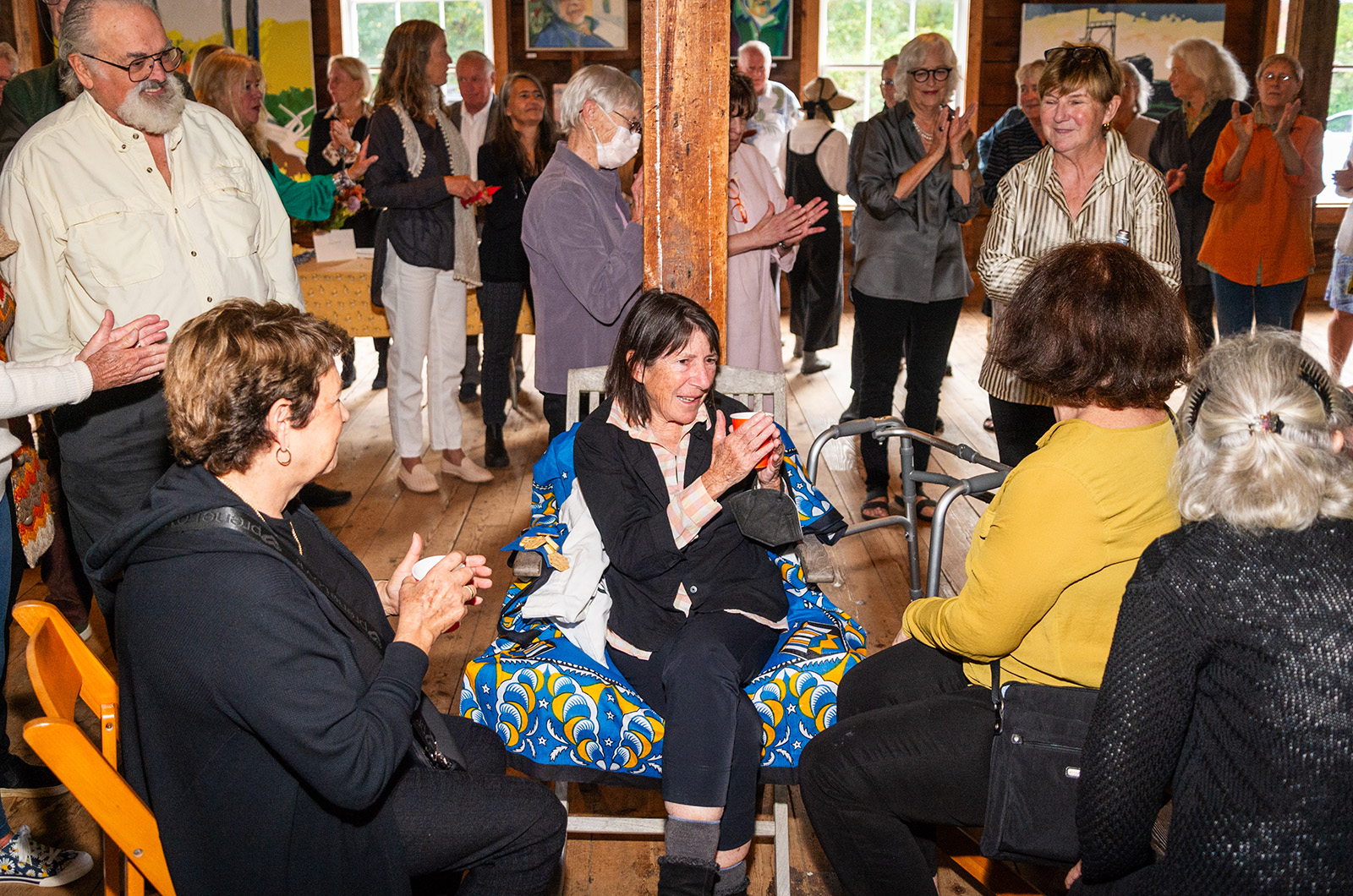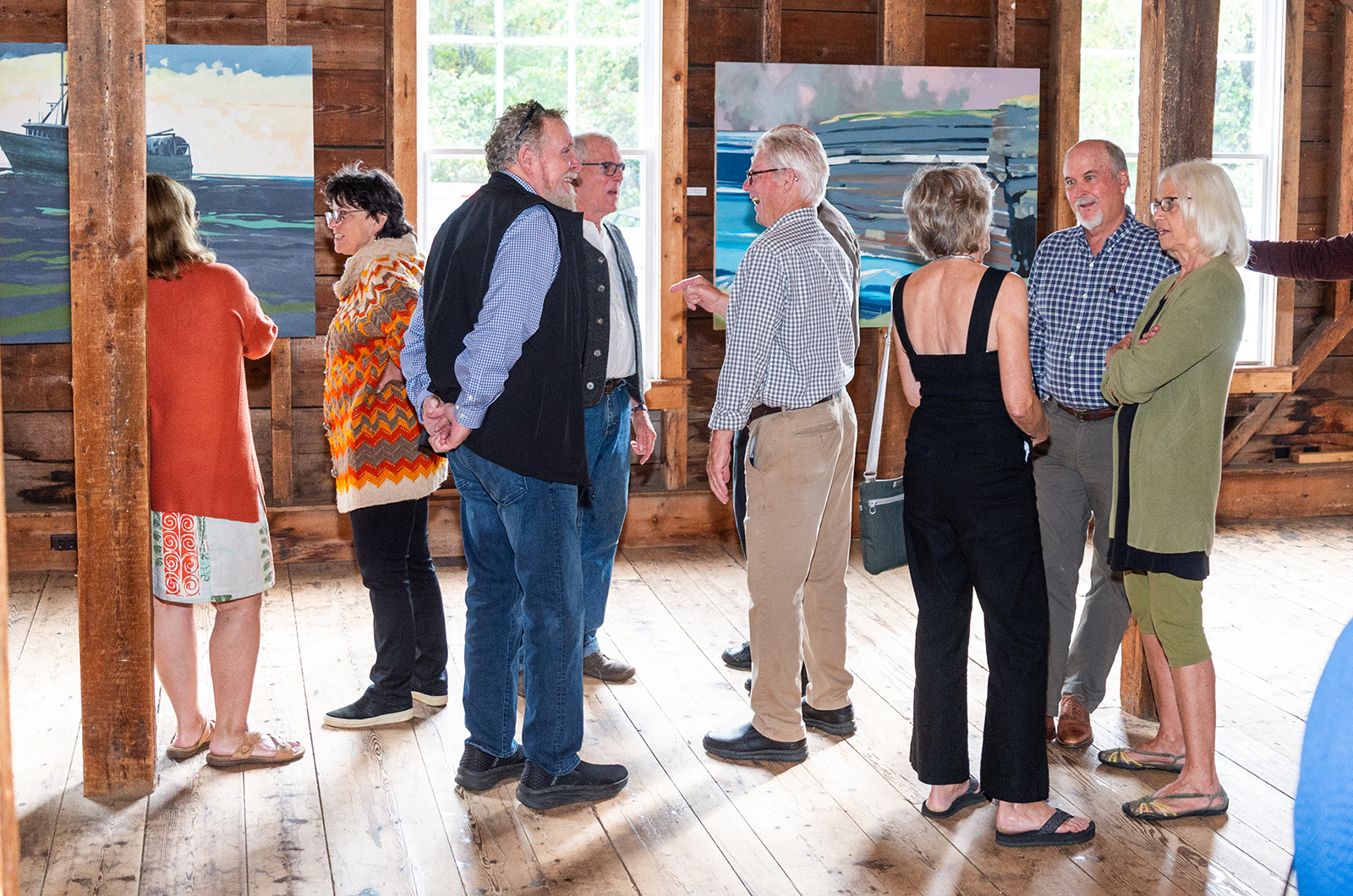A special exhibition honoring Rez Williams, the West Tisbury painter and conservationist who died at 81 earlier this year, brought a crowd of Island artists, art-lovers and environmentalists to Grange Hall Saturday afternoon.
Co-curated by Mr. Williams’s widow, the artist Lucy Mitchell, and his Island gallerist Tanya Augoustinos, the brief but expansive show spanned his career from the 1980s to his final year.
Along with the large, colorfully abstract paintings of fishing boats, coastal landscapes and untouched nature that Mr. Williams was best known for, he also painted many self-portraits, which Ms. Mitchell and Ms. Augoustinos showed at the Grange alongside his work from the corresponding period.
“It’s nice to see Rez again,” said Luanne Johnson of the wildlife nonprofit Biodiversity Works, pausing before a set of five self-portraits of the artist in different moods.
Ms. Johnson is one of many Islanders who knew Mr. Williams as a staunch conservationist as well as a gifted artist. He was one of the Vineyard Conservation Society’s longest-serving board members, and a past president of the Sheriff’s Meadow Foundation.
“You could always count on Rez to be there [for] nature,” she said.
At Saturday’s exhibition, a dapper Mr. Williams in a cap — already wearing his trademark horn-rims glasses — glanced obliquely out from a late-1980s piece, hanging near two scenes of Vineyard Haven harbor from the same era.
Nearby but overhead, in a self-portrait hung above one of his Monhegan Island paintings from 2016, an older Mr. Williams seemed slightly bemused, as though wondering if all the people filling the Grange were really there on his account.
“He was always, to use his one of his favorite words, astonished that people loved his work,” said Ms. Augoustinos, who represented Mr. Williams at her A Gallery beginning in 2012.
One of the Island’s leading landscape artists, he won wider recognition after he was praised in 1995 by Thomas Hoving, then director of the Metropolitan Museum of Art, as among the finest living artists in America.
“He was recognized for being underrated,” said Ms. Augoustinos, who considers Mr. Williams a ground-breaking painter worthy of international attention.
“He was a phenomenal, iconic painter for the Island, but beyond that... he combined abstraction with representational art in a way that’s so unique,” she said, citing the Monhegan Island series.
Working from photographs, she said, Mr. Williams carefully extracted the essence of a scene by removing everything inessential, transforming a coastal snapshot filled with underbrush and background details into the painting Odalisque, which centers on a downed tree — naked of bark and bristling with limbs — set amid planes of color conveying sea, stone and vegetation.
Mark Riesman, a seasonal Islander who has collected some of Mr. Williams’s paintings, sees the Monhegan Island paintings as another advance in the artist’s continuing development.

“They’re so loose and so confident. It was remarkable. I admired him for that,” Mr. Riesman told the Gazette at Saturday’s show.
“[In] my point of view, unlike a lot of painters — particularly people who’ve been painting as long as he painted — he got better and better and better,” Mr. Riesman said. “He never plateaued.... He was brave.”
Mr. Williams’s large-scale boat paintings were another highlight of Saturday’s show. Here, too, Ms. Augoustinos said, one can trace the artist’s journey toward more abstract, minimalist visions of the towering, glossy-green hulls of New Bedford fishing boats.
In his final boat painting, finished but not yet titled when he died, Mr. Williams pulled back again for a full view of a smaller commercial fishing vessel, silhouetted against a fog bank as it plies a calm sea of greens and blues. Above the fog is a band of dark-blue sky.
Although he used a palette of colors derived from Dutch master painters of the 17th century, Ms. Augoustinos said, Mr. Williams himself never stopped looking ahead.
“He didn’t make artwork with commercial outcomes in mind. He really explored things, and to see how he could push himself,” she said.









Comments
Comment policy »